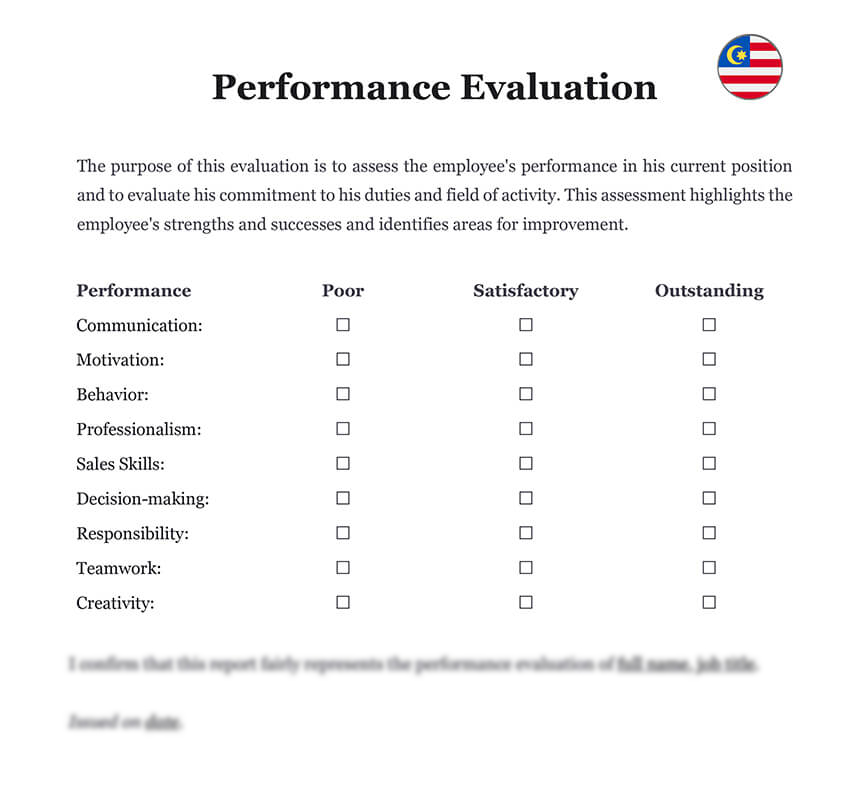Ready to use legal template
Work on without any hassle
Compliant with Malaysian law
Ready to use legal template
Work on without any hassle
Compliant with Malaysian law
Learn more about Employee Performance Evaluation in Malaysia
The employee performance evaluation is a useful tool for employers in Malaysia, as it allows them to assess the performance of their employees, identify areas for improvement and determine opportunities for growth and development. This document verifies that the tasks and responsibilities written in the Employment Contract are met and can be used to determine employee compensation and promotions. Download our employee performance evaluation template to ensure that your company has competent and productive employees. The employer can then write an Employment Warning Letter to address disciplinary issues or even use our Employment Termination Letter for dismissal.
Table of contents
-
What are the key components of an employee performance evaluation?
-
How does the evaluation affect compensation and promotions?
-
What challenges when conducting employee performance evaluation?
-
How does the evaluation improve performance and productivity?
-
How can technology be used to streamline the evaluation process?
-
What are the legal considerations for conducting evaluations?
-
How to conduct an evaluation in a culturally diverse workplace?
What are the key components of an employee performance evaluation?
The key components of an employee performance evaluation in Malaysia typically include a review of an employee’s job performance, productivity, and attendance. Employers may also consider an employee’s skills, abilities, and potential for growth and development. Communication and teamwork skills, as well as adherence to company policies and procedures, are also typically evaluated. In addition, evaluations often include a self-evaluation, in which the employee provides their own assessment of their performance. The manager’s evaluation is also included in the process. Employers may also use additional tools such as 360-degree feedback, where input is gathered from the employee’s peers, direct reports, and/or supervisors. The evaluation process may be done annually, semi-annually or quarterly depending on the company’s policies.
How does the evaluation affect compensation and promotions?
An employee performance evaluation can be used to determine compensation and promotions by providing a comprehensive assessment of an employee’s job performance, productivity, and abilities. Employers can use the information gathered during the evaluation process to determine if an employee is meeting or exceeding expectations and if they are ready for a promotion or deserve a raise. For example, if an employee demonstrates strong leadership skills, a strong work ethic, and a willingness to take on additional responsibilities, they may be considered for a promotion. Additionally, if an employee consistently meets or exceeds their performance goals, they may be eligible for a raise or bonus.
ℹ️ By linking an employee’s performance to their compensation, employers can ensure that they are rewarding their top performers and motivating employees to improve their performance. Employers may choose to write an Employment Warning Letter to keep the employee informed of poor performance.
What challenges when conducting employee performance evaluation?
There are several common challenges faced by employers when conducting employee performance evaluations. One of the biggest challenges is ensuring that the evaluation process is fair and unbiased. Employers may struggle to accurately assess an employee’s performance if they are not familiar with their work or if they have personal biases towards the employee. Another challenge is ensuring that the evaluation process is objective. Employers may have trouble separating an employee’s personal traits from their job performance, which can lead to inaccurate evaluations. Communication is also a common challenge, particularly for employees who speak different languages or have different cultural backgrounds. Employers may have difficulty communicating effectively with employees, which can lead to misunderstandings and dissatisfaction with the evaluation process.
- Remarks:
the lack of proper tools and technology to conduct employee performance evaluations can also be a challenge for employers in Malaysia. Employers also face the challenge of ensuring they are in compliance with labor laws and union agreements when conducting evaluations.
How does the evaluation improve performance and productivity?
An employee performance evaluation can be used to improve performance and productivity in a number of ways. One way is by providing a clear and objective assessment of employee performance. This can help managers identify areas where employees need improvement and provide targeted feedback and training to help them improve.
Additionally, by linking employee performance to rewards such as promotions and raises, employers can motivate employees to improve their performance. Employers can also use the data collected from employee evaluations to make data-driven decisions that can improve performance and productivity in the organization. By regularly conducting employee performance evaluations, employers can stay informed about employee performance over time and make adjustments as necessary to improve performance and productivity.
Furthermore, by incorporating employee input into the performance evaluation process, employers can ensure that evaluations align with employee’s own perception of their performance and that evaluations are based on accurate information. Overall, an employee performance evaluation is a powerful tool for identifying and addressing performance issues and for promoting a culture of continuous improvement within the organization.
How can technology be used to streamline the evaluation process?
Technology can be used to streamline the employee performance evaluation process in Malaysia by automating many of the tasks associated with the evaluation process. Some examples include:
1. Online forms: using online forms can make it easier for employees to provide their own assessment of their performance, and for managers to provide feedback on employee performance.
2. Automated reminders: setting up automated reminders can ensure that evaluations are conducted on a regular schedule and that employees are aware of when their evaluations are due.
3. Data analysis tools: many software tools can be used to help managers analyze employee performance data, and to make data-driven decisions.
4. Cloud-based software: Cloud-based software can allow for easy access to employee performance evaluations from any device, at any time, and from any location.
5. Automated report generation: Automated report generation can save time and resources by automating the process of generating and distributing reports.
6. Mobile apps: mobile apps can be used to conduct evaluations remotely, making it easier for managers to conduct evaluations even when they are not in the office.
7. Automated feedback: Automated feedback tools can be used to provide employees with real-time feedback on their performance, helping them to identify areas for improvement and track their progress over time.
What are the legal considerations for conducting evaluations?
There are several legal considerations that employers must keep in mind to ensure compliance with labor laws, non-discrimination laws and data protection laws.
One important consideration is to ensure that the evaluation process is fair and unbiased, and that it does not discriminate against employees on the basis of race, religion, gender, age, or other protected characteristics.
Employers must also make sure that employees are provided with clear and objective criteria for evaluating their performance and that the evaluation is based on these criteria and not on personal biases.
Additionally, they must ensure that employees are given an opportunity to provide their own assessment of their performance, and that their feedback is taken into consideration. They should be sure that the evaluations are conducted in a confidential manner, and that they are not shared with unauthorised individuals or organizations. They should have a proper system in place to store and manage the evaluations and that they are being done regularly and timely, and in compliance with data protection laws.
Lastly, employers should ensure that they are in compliance with any relevant labor laws, such as the Employment Act 1955, and union agreements that may apply to performance evaluations in Malaysia.
How to conduct an evaluation in a culturally diverse workplace?
When conducting employee performance evaluations in a culturally diverse workplace, it is important to take into account the cultural backgrounds of the employees being evaluated. Some best practices include:
| ➤ Fairness and objectivity: Ensure that the evaluation process is fair and objective, and that it does not discriminate against employees on the basis of race, religion, gender, age, or other protected characteristics. |
| ➤ Clear and objective criteria: Provide clear and objective criteria for evaluating employee performance, and base the evaluation on these criteria rather than personal biases. |
| ➤ Self-evaluation: Provide employees with an opportunity to provide their own assessment of their performance and to take their feedback into consideration. |
| ➤ Confidentiality: Ensure that the evaluations are conducted in a confidential manner, and that the evaluations are not shared with unauthorised individuals or organizations. |
| ➤ Translation or interpretation: Consider hiring a translator or language interpreter, or training managers to communicate in different languages to ensure effective communication. |
| ➤ Cultural sensitivity training: Provide cultural sensitivity training to managers and employees to help them understand and appreciate different cultural backgrounds and values. |
| ➤ Employee input: Incorporate employee input into the performance evaluation process to ensure that evaluations are fair and objective and based on accurate information. |
| ➤ Regular evaluations: Conduct evaluations regularly, this will help to ensure that evaluations are conducted in a timely manner and that the feedback provided is up-to-date. |




